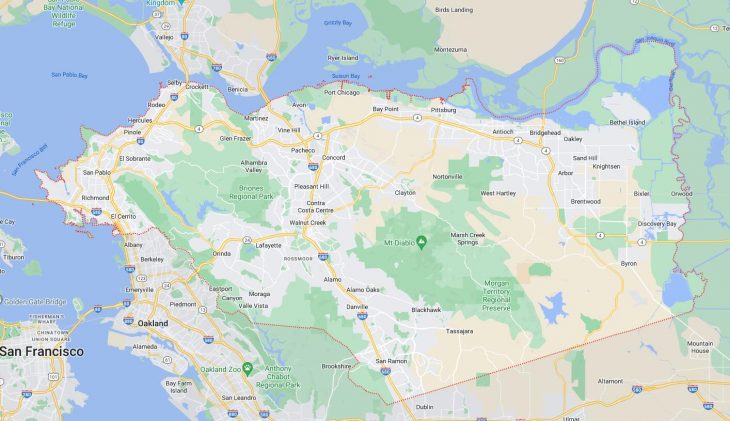Cities and Towns in Contra Costa County, California
Founded in 1850, Contra Costa County is one of 58 counties in the state of California. The city of Martinez is the county seat. With FIPS code of 13, Contra Costa County has a population of 1,161,413 and area of 720 square miles (1,865 km²).
List of all cities in Contra Costa County, CA alphabetically
| City/Town | Postal Code | Area Code |
| Alamo, CA | 94507 | 925 |
| Antioch, CA | 94509 | 925 |
| 94531 | 925 | |
| Bay Point, CA | 94565 | 925 |
| Bethel Island, CA | 94511 | 925 |
| Blackhawk, CA | 94506 | 925 |
| Brentwood, CA | 94513 | 925 |
| Briones, CA | 94553 | 925 |
| Byron, CA | 94505 | 510 |
| 94514 | 925 | |
| Canyon, CA | 94516 | 925 |
| Chevron, CA | 94529 | 925 |
| Chevron USA Inc, CA | 94529 | 925 |
| Clayton, CA | 94517 | 925 |
| Clyde, CA | 94520 | 925 |
| Concord, CA | 94518 | 925 |
| 94519 | 925 | |
| 94520 | 925 | |
| 94521 | 925 | |
| 94522 | 925 | |
| 94523 | 925 | |
| 94524 | 925 | |
| 94527 | 925 | |
| 94529 | 925 | |
| Crockett, CA | 94525 | 510 |
| Danville, CA | 94506 | 925 |
| 94526 | 925 | |
| Diablo, CA | 94528 | 925 |
| Discovery Bay, CA | 94505 | 510 |
| Discovery Bay, CA | 94514 | 925 |
| El Cerrito, CA | 94530 | 510 |
| El Sobrante, CA | 94803 | 510 |
| 94820 | 510 | |
| Hercules, CA | 94547 | 510 |
| Hilltop Mall, CA | 94806 | 510 |
| Knightsen, CA | 94548 | 510 |
| Lafayette, CA | 94549 | 925 |
| 94596 | 925 | |
| Martinez, CA | 94553 | 925 |
| Moraga, CA | 94556 | 925 |
| 94570 | 925 | |
| 94575 | 925 | |
| North Richmond, CA | 94801 | 510 |
| Oakley, CA | 94561 | 925 |
| Orinda, CA | 94563 | 925 |
| Pacheco, CA | 94553 | 925 |
| Pinole, CA | 94564 | 510 |
| Pittsburg, CA | 94565 | 925 |
| Pleasant Hill, CA | 94523 | 925 |
| Point Richmond, CA | 94801 | 510 |
| Port Chicago, CA | 94565 | 925 |
| Port Costa, CA | 94569 | 510 |
| Richmond, CA | 94801 | 510 |
| 94802 | 510 | |
| 94803 | 510 | |
| 94804 | 510 | |
| 94805 | 510 | |
| 94806 | 510 | |
| 94807 | 510 | |
| 94808 | 510 | |
| 94820 | 510 | |
| 94850 | 510 | |
| Rodeo, CA | 94547 | 510 |
| 94572 | 510 | |
| San Pablo, CA | 94803 | 510 |
| 94806 | 510 | |
| San Ramon, CA | 94582 | 925 |
| 94583 | 925 | |
| Tara Hills, CA | 94806 | 510 |
| Walnut Creek, CA | 94595 | 925 |
| 94596 | 925 | |
| 94597 | 925 | |
| 94598 | 925 | |
| West Pittsburg, CA | 94565 | 925 |














































